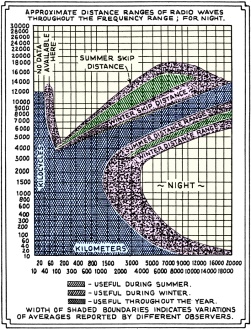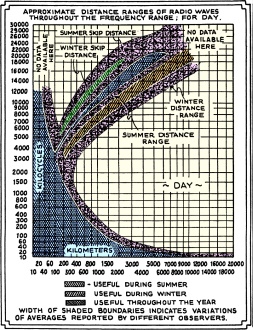Summer Short-Wave Reception
|
|
Summer Short-Wave Reception A comprehensive discussion of the factors which influence short-wave reception during both day and night. Radio wave transmission takes place by the propagation of a "ground wave" along the ground, or a "sky wave" reflected or refracted from the Kennelly-Heaviside layer, or by both means. The waves are subject to absorption, both in the ground and in the ionized upper atmosphere. The ground-wave absorption, in general, increases with frequency and is reasonably constant, with time, over a given path at a given frequency; it varies for earth of different conductivities and dielectric constants. The sky-wave absorption is not a constant with time, frequency, or path; it appears to be a maximum in the broadcast band (550-1500 kc.), decreasing with change of frequency in either direction. In the daytime this absorption of the sky wave is so great that there is practically no sky wave, from frequencies somewhat below to somewhat above the broadcast band, the specific limits varying with the season. Hence sky-wave propagation in the daytime is only appreciable in the lower and higher frequency ranges. During the night, however, sky-wave propagation takes place on all except extremely high frequencies. Sky-wave propagation is subject to material variations, dependent upon conditions and changes in the ionization of the Kennelly-Heaviside layer. Besides daily variation of daylight and darkness, factors such as latitude, season, magnetic storms; and solar disturbances, have been found to have effects upon this ionization. These changes in ionization result in wide variations in the transmission of sky waves from hour to hour, day to day, and year to year. At the higher frequencies, received field intensities for a given season and frequency may vary as much as 1 to 10 from one year to another. At the higher frequencies, reception at great distances is due entirely to the sky wave. Above a certain frequency, however, which may be as low as 4000 kc (see attached graphs), no appreciable portion of the sky-wave radiation is reflected back to earth from the Kennelly-Heaviside layer in a certain zone surrounding the transmitter. In the area bounded by the inner edge of this skipped zone, the received wave may be composed of both ground wave and sky wave (the sky wave being appreciable on frequencies up to about 6000 kc. in the summer and 12,000 kc. in the winter); the sky wave intensity in this area is ordinarily much less at night than in the day, The outer boundary of the skipped zone is often called the skip distance. The skip distance increases with frequency, and varies diurnally and seasonally. Beyond the skip distance, the sky-wave radiation is received with useful intensity. With present knowledge of propagation conditions it is impossible to postulate any formulas or make any tables or charts which could be used to determine distance range over any given path accurately. The attached graphs give average distance ranges as observed by a number of experimenters to occur most frequently over a number of transmission paths. Through certain frequency ranges, available data were so incomplete as to require extrapolation which may be considerably in error. Wide variations of distance range and skip distance must be accepted as normal. The scales of abscissas and ordinates are cubical, (i.e., numbers shown are proportional to the cube root of the numbers shown). This scale was chosen because it spaces the data satisfactorily. A linear scale would crowd the low values too much and a logarithmic scale would crowd the high values too much. The graphs show the limits of distance over which practical communication is possible. They are based on the lowest field intensity which permits practical reception in the presence of actual background noise. For the broadcasting frequencies this does not mean satisfactory program reception. The limiting field intensity is taken to be 10 microvolts per meter for frequencies up to 2000 kc. decreasing from this value at 2000 kc. to about 1 microvolt per meter at 20,000 kc. When atmospherics or other sources of interference are great, e.g., in the tropics, much larger received field intensities are required and the distance ranges are less. The graphs assume the use of about 5 kilowatts radiated power, and non-directional antennas. For transmission over a given path, received field intensity is proportional to the square root of radiated power, but there is no simple relation between distance range and either radiated power or received field intensity. Separate graph sheets are given for day and for night transmission. Above about 3000 kc. as shown, the distance ranges (and in most cases also the skip distances) are greater in the winter than in the summer. The distance ranges in spring and autumn are intermediate between the limits shown for summer and winter. In general, the distance ranges for paths which lie partly in day and partly in night portions of the globe are intermediate between those shown in the day and the night graphs. For such paths, the distance ranges are greater than would be expected from inspection of the day graph, as the waves under these conditions travel over greater distances in the illuminated portion of the earth's surface; for this reason it is possible to use a lower frequency for a part day, part night path than is indicated for the day portion of the path on the day graph. The distance ranges given in the graphs are the distances for reliable reception; they are not the limits of distance at which interference may be caused. A field intensity sufficient to cause troublesome interference may be produced at a much greater distance than the maximum distance of reliable reception.
Posted August 4, 2023 |
|



